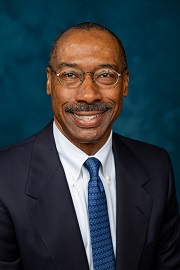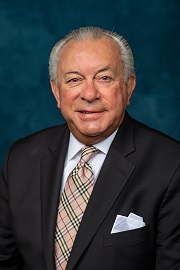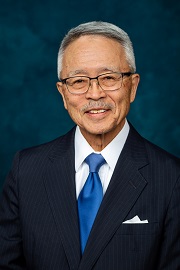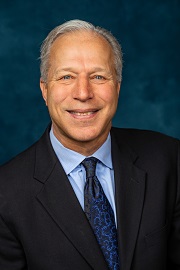
Our R|L Coaches weigh into this group blog with their favorite metaphors, images, and stories to help shift our thinking. These word images help us describe and deepen an experience, simplify a complex or abstract thought, or motivate us to explore a new direction. With these memorable stories, we contextualize our understanding, gain encouragement, and bring lasting recall to our learning.
Which of the following metaphors, images, or stories below will you employ to shed new light on a difficult problem you are currently experiencing? What helps you shift your mindset?

Clyde Lowstuter, MCC |
No One Benefits from Your Playing Small
Our office complex is nestled in what could be described as a wildlife sanctuary. My favorite birds are the great herons. With their massive wingspan, they gracefully soar overhead for extended periods, then suddenly they dive toward the surface tucking in their wings before slicing under the water’s surface to spear a big fish. That’s what herons do; they fly, they dive, they eat . . . and repeat. Their behavior is imprinted at the DNA level. I’m struck by the realization that all the animals “play full out.” None of the herons, coyotes, otters, deer, turkey vultures, or owls that pass by my windows are worried about what the other creatures think of their looks or performance. Herons don’t condemn each other for missing a fish, nor does the heron that lost it sulk and hide in shame. If only we humans had the capacity to consistently “play full out” and not hold back. Demand the best from yourself because everyone, including you, deserves it. Whatever you are engaged in, dig deep and give it your all. When you do, you are modeling the kind of authentic behavior and enhanced courage that you want others to access for themselves. Reproduced with permission from Clyde C. Lowstuter, 35 Truths: Lessons from the front lines of Executive Coaching, (Bannockburn, IL: R|L Communication, Inc., 2017). |

Carolyn Lowstuter |
The Big Rocks
Stephen Covey shares a memorable illustration. A motivational speaker stood in front of an audience of business students. On the table in front of him, he pulled a one-gallon wide-mouthed mason jar towards himself and placed a dozen fist-sized rocks into the jar. When the rocks were up to the top, he asked, “Is this jar full?” Many said, “Yes.” Next, he reached under the table and pulled out a bucket of gravel. As he poured in several spoonfuls, he shook the jar causing the pieces to work themselves down into the spaces between the rocks. He smiled and asked the group, “Is the jar full?” By this time the class was on to him and answered, “Probably not.” “Good!” he replied. Next, he poured in a cup of sand which shifted in between the spaces left between the rocks and the gravel. He asked again, “Is this jar full?” “No!” the students exclaimed. Next, he grabbed a pitcher of water and began to pour it in until the jar was filled to the brim. One student jumped ahead to share the point of this illustration by saying, “No matter how busy and full our schedule is, there is always room to fit something more into it.” The speaker replied, “No, that’s not my point. The truth this illustration teaches us is: If you don’t put the big rocks in first, you’ll never get them in at all.” What are the big rocks and key priorities that you are trying to fit in this week? What is the truly essential work that needs to be done? Uncover your biggest rocks and begin with these! |
|
Nora Bouchard |
Defining Leadership through Metaphor Metaphors are wonderful tools: a simple language construct that helps us approach topics that may be uncomfortable to deal with directly or just difficult to think about in the abstract. These metaphors tend to take the form of agreed-upon roles, stories, or archetypes. As coaches working with leaders, we often talk about concepts that are hard to define. For example, when we think of the concepts of “leadership” or “team,” we find these terms can be hard to grasp. We all have so many ideas of what these two words mean. But, we can use metaphors to help us all agree on the relevant conceptual meaning. For example, when I work with teams on how best to improve, I sometimes ask them to consider what type of sports team they most resemble. Some work teams are composed of individuals doing disparate tasks, rarely interacting with each other. But, they are still considered a team. Using a sports metaphor, we can see that neither a football nor a baseball team would work in this case, but perhaps a tennis team would. Tennis teams are composed of individuals, each trying to win their own matches. When they aren’t competing, however, they do support one another. They practice together. They cheer each other on. They challenge each other. And they help each other get better. They form a real team, but they have a clear understanding of boundaries and what they can and cannot do for each other. We can apply this same metaphor to work teams composed of individual contributors. Rather than seeing them as a disparate group of people working toward their own goals, we can see them as a tennis team, a group of people ready to support each other behind the scenes. I’ve used metaphor to help people widen how they see their roles, their influence, and their life’s purpose. It’s a powerful option for any coaching conversation. |

Susan Snowden |
Dimmer Switch
We live in change. Some change is like a light switch—snapping on and off. We are blinded by the light one moment and in the dark the next. This type of change, shocking and disconcerting, often marks significant shifts in our lives—sometimes good, sometimes bad, but always urgent and intense. If only change were put on a dimmer switch—nice and smooth. The change would be an adjustment, not a shock. Unfortunately, the default reaction to change is often more like the light switch than the dimmer switch. How many real emergencies have you experienced in your business career? How many moments of change are treated as an emergency because of the light switch mentality? How many times have you experienced a leader’s reversal enflaming the issue rather than helping? Do you trust a leader who flips like a switch? Does it build confidence? It is easier to pinpoint the light switch moments in others, but we all have them. Upon discovering a weakness, have you ever said, “I will never again . . .”? (You know the “never again . . .” if you have said it.) It is an important phrase because it recognizes a need for change, and it also draws a clear boundary line. The problem is that there is no flexibility, no grace. It is a light switch statement and once you fail, it’s turned off. Instead, the dimmer switch would allow some latitude of change to occur over time. It gives you the freedom to experiment with new behaviors and gives your colleagues the time to adjust to your recent strengths and perspectives. The dimmer switch can build trust, which is crucial in authentic leadership. Don’t toss out the light switch; it is necessary for an emergency where immediate and instantaneous change is required. Use the dimmer switch to bring along others for lasting and integrated change. Challenge yourself to notice how you are reacting in each situation. Ask yourself: Is this a light switch or a dimmer switch moment? Make your choice situationally. |

Pat Mater |
Destination Unknown
When COVID hit, our world was reordered—many of my clients lost the stabilizers that normally held together the delicate framework of their work/life balance. Schools were shut. Daycare closed. House cleaners were on lockdown. Grandparents that had helped stayed home. The longer the pandemic wore on, the more I heard from my clients that they feared they weren’t doing justice to their jobs nor their families. Something different needed to happen. As my clients and I began to explore what they wanted out of their life and career, I began to see careers as a highway. Some of my clients cut out everything non-essential to set their cruise control at a steady pace. Others have needed to take an exit ramp temporarily leaving their careers. Wherever you find yourself, remember: Your career is a highway. Sometimes you need an exit ramp rather than continuing to drive 10 miles over the speed limit. You can choose an on-ramp later if you want. |

Dave Dallam |
A Coaching Metaphor
Metaphors are powerful coaching tools: they seek to inform by drawing parallels between something hidden and things commonly known to the person receiving the coaching. Have you ever listened to your own recorded voice? While it will sound foreign to you, it is the voice that everyone else hears. Have you ever looked at a picture of yourself that you didn’t like, yet have your spouse comment that this picture captures something they particularly like about you? Combine these ideas in a recorded video of yourself and notice your level of shock and self-criticism. These are excellent metaphors to discuss our gaps in self-awareness. The picture, the voice, and the video capture you exactly as others see and hear you, and not the self that you may project. Clear recognition of the self that we project leads to acceptance of feedback from others, a critical element in a coaching assignment, and closing these gaps is often an important component in coaching, leading toward greater authenticity. |
|
Sharon Noha |
When You’re Stuck, Others Get Stuck, Too!
What started as a local Egyptian issue turned into international news as the Ever Given, a 220,000-ton ship remained stuck, straddling and blocking the Suez Canal. With $9B in daily trade usually cruising through this canal, it wasn’t long before this stranded vessel had created a huge backlog. It took local workers, engineers, tug boat captains, dredgers, diggers, and ultimately tides to free this skyscraper-sized vessel. We all get stuck at some point in our careers. Stuck in the wrong role, with a bad boss, misaligned with the culture, underutilized, unfulfilled, off-track…so many things can take us off the course we had planned for ourselves. Usually, it’s not easy to get unstuck by ourselves. When you do get stuck for any number of reasons, seek out others whose counsel and advice you respect. Take little steps in the right direction; like this huge vessel, getting unstuck doesn’t usually happen overnight. When things aren’t right for you, it can have a ripple effect on your boss, your team, the company’s performance, and even your home life. How many of you didn’t get a shipment this past week due to something occurring halfway around the world? Getting unstuck can be overwhelming initially, but it is freeing for yourself and others once you gain momentum. The entire world celebrated when the Ever Given began to float once again. Your world will celebrate when you start shifting. You are worth the effort! Take a baby step today. |
|
Kevin Price |
Courage and Authenticity Produce Confidence!
Last week I had the opportunity to meet with the founder of a publicly traded company, of which he remains the largest shareholder. As I prepared for the meeting, I found myself devouring his recently published business book. The more I learned about him and the company the more impressed I became. The more impressed I became the more nervous I got. How would I show up? Would my background be impressive enough? Would my experience showcase all of my talents? Would the conversation flow or grow awkward? As my stress grew, a mentor wisely advised me to do just one thing— be myself. His simple words of wisdom settled me and I refocused my efforts pivoting from concern to courage. When I approached this meeting from an authentic state I knew exactly what to do:
When I went into the meeting as my authentic self, I trusted that my intended message would be heard and fully understood. My mentor reminded me that I show up as my best self when I show up as myself. Be aware, others will see value in you that you might not anticipate. Be open to praise as well as feedback. Courage and authenticity produce confidence! Be yourself today. |
|
Anil Shah |
Failure Can Be Success
Early in my career, I was on a team that lost a big account. In the weeks that followed, there was a lot of blaming and finger-pointing, but not a lot of work was done. One day our boss called a team meeting. I thought we were all going to be dismissed. Instead, our boss told us this story: A young salesman in his 20s was working for a large corporation. He was responsible for managing one large account in his portfolio. He thought he was excelling at his job. One day, he was told he had lost the account and if he lost another he would lose his job. The young man panicked; he was worried about how he was going to support his wife and a newborn baby. He played it safe with his other accounts and nearing the end of the quarter he shifted from being a top performer to the lowest performer. He went home and told his wife that his fear of losing his job was going to make him actually lose his job. “How about the next 5 to 7 years?” His answer was, ”Maybe.” “How about 20 years from now?” and his answer was, “Probably not.” “What about 40 years from now?” His answer was, ”Most definitely not.” She said, “Do not let one failure impact your life.” My team took this story and regrouped. We would not let the failure change our lives. We would use the failure as a springboard for future successes. Are you thriving? Examine what areas of your life lack luster. How can you use your failures as springboards to succeed? |
|
Mike N. Cannizzaro |
Apply the Strengths You Exhibit Outside of Work to the Challenges You Are Faced With at Work As coaches, we are trained that our job is to work with our clients to get them to reveal the answers to their problems that lie within them. Our role is not to advise, although we may encourage or challenge. Learning about the whole person helps to coach them. Listening to how they apply their strengths outside of work often gives insight into opportunities at work. So often, to fit into company cultures employees are required to leave so much of who they “really” are outside of work in the personal realm. I’ve found that often employees leave some of their strongest attributes in the personal realm, not seeing how those skills can be applied to work. People may exhibit competencies like coaching, leadership, presentation skills, or building effective teams as they volunteer their service in athletic teams, youth organizations, schools, church, or fraternal organizations, meeting a host of challenges. However, they fail to see how they can, and should, apply those same skills at work. They have so successfully compartmentalized work and service, not recognizing the tool to fix the work problem is in their personal toolbox they use for service. I once coached a manager who didn’t delegate effectively. He quickly and routinely defaulted to “doing” rather than delegating. Away from work, he coached little league teams that regularly won championships. I highlighted that as a baseball coach, he was not able to hit, run, catch, or score for his team. He had to “delegate” those tasks; he had to coach. His team had to be the “doers.” I encouraged him to apply those same coaching skills to his team at work. By applying his coaching skills, he increased his effectiveness and the effectiveness of his work team. When faced with a problem or challenge at work, ask yourself how the challenge is similar to a challenge you handle outside of work. Focus on what’s similar between the two challenges, exploring how you might apply your skill. |

Kathryn Hartrick |
Perspective Clock
I am endlessly fascinated with the dualistic nature of truth. On the surface it seems simple, something is right or wrong, but the whole truth is not always easily obtainable. It is inexorably linked to perspective. One of my roles in coaching is conducting 360° interviews. It is critical to gain a broad and holistic perspective of an individual’s behavior from both opponents and proponents, from all levels of an organization. Why might some colleagues experience my coaching client so differently? While urgency is often a high priority in conducting the feedback assessments, not obtaining feedback from a variety of important stakeholders may be detrimental. It could mean sizing up a client from a distorted or limited viewpoint. I like to think of perspectives like a clock, broken into segments. Each segment is comprised of people who interact and work with my client. The first 25% of the clock represents the people directly involved with the client and who experience their behavior on a regular day-to-day basis. The next 25% represents the leaders, advocates, and mentors who directly interact with the client. The next 25% represents peers. The last 25% represents people who are indirectly involved but directly impacted by the client’s behaviors. If you only look at 75% of the clock face, you may be right most of the time. You may come up with a fairly accurate client assessment. However, if the missing or unknown 25% is directly related to different or unique client behaviors, you’ll be wrong. How wrong is dependent on the situation at hand. To be thorough, you need to access all of the time represented on the clock. Before you claim something as right or wrong, ask yourself, am I seeing the whole clock? Is it worth it to have the incorrect time 25% of the time? Truth needs to be impartial. Truth sees the whole picture, the entire clock. |
|
Ron Hirasawa |
The Breakfast of Champion Leaders! When I started to explore what helps me shift my mindset, I kept returning to feedback. It can be difficult when we get into a routine groove to see that a shift is even necessary. Feedback is the best way I have found to help me refine my performance. The best feedback is timely, empathetic, specific, and actionable. One impactful model to build awareness is the short and specific “feedback sandwich,” utilizing a Continue, Stop, Start format structured like this: “When you do X (specific behavior), I feel Y (emotion).” The result is: my reflective behavior. For example, (CONTINUE)…I appreciate your including me in C-level meetings. When you do, I feel involved and visible. And the result is that you motivate me to perform beyond expectations and prepare for top management questions. (STOP)…When you criticize my presentation in front of other managers, I feel betrayed instead of supported, especially since you had already reviewed it. The result is I become passive, waiting to be told what to do. (START)…I wish you would start providing more timely feedback as an issue unfolds. When you give me timely feedback, I can lead my team to immediately address the problem. The result is we show a united front with an urgent solution. When this action item leans to the positive, it is most effective. This helps create momentum and solidify a changed behavior. When I work with the feedback sandwich, I find that it gives my clients a framework from which to make actionable, meaningful change. What can you continue, start, stop doing today? |
|
Matt Gonring |
Students of Culture, Better Outcomes With employee tenures decreasing with each corresponding generation, it’s becoming more difficult to invest enough time in your company to truly understand how it works. We all agree that forging relationships and knowing how to successfully traverse organizational dynamics takes time—after all, that’s what onboarding is all about. I was new to a large corporation, joining as a director and aiming for establishing myself and my function at the leadership/officer level. I developed a strong relationship with the head of labor and regulatory affairs who had begun his career on the line and had 25 years invested. We became close, and he offered to be a sounding board for me in advance of important policy conversations with the CEO and other functional leaders. He knew them all well and was completely anticipatory of how they thought; he had made a study of how decisions got made and how to find his way successfully. He was so accurate in how others would respond that I found it hard to keep a straight face as he predicted to a word what others would say and how they would react. My colleague’s sharing of his experience and knowledge of the culture enabled me to develop relationship capital sooner and avoid pitfalls. Ultimately, I became more successful thinking about the outcomes I wanted from these conversations because I already knew how others would react. It gave me greater self-confidence and stronger relationships and helped me successfully reach the officer level. Finding the students of culture and asking for their help along the way is a great way to add experience when there never seems to be enough time to do it on your own.
|







